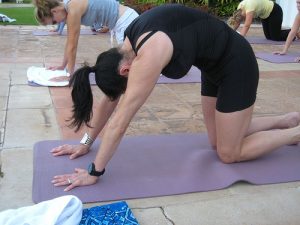Why Yoga Practice Eases Eating Disorder Symptoms
 Exercise that focuses on burning calories, losing weight, or sculpting the body can play into the fear and body dissatisfaction that underlies eating disorders.
Exercise that focuses on burning calories, losing weight, or sculpting the body can play into the fear and body dissatisfaction that underlies eating disorders.
Even if aerobic or toning exercise goals are met, a thinner and more shapely individual with an eating disorder will still see a distorted self-image in their mind’s eye – or in a mirror.
A mind-body exercise such as yoga maintains a different focus, and that is why it can help people recover from eating disorders. The goal of practicing yoga is to strengthen the body and the mind, and to strengthen the connection between them.
The poses and breath-work of yoga practice:
- ~ build stamina and strength
- ~ maintain the body’s flexibility
- ~ teach mindfulness, or having a still mind
- ~ promote the balance of all bodily systems
- ~ teach people to listen to and trust their body
- ~ help people let go of self-judgment
A research study, published in Psychology of Women Quarterly, reveals that mind-body exercise is correlated with better body satisfaction and fewer eating disorder symptoms than aerobic exercises such as cardio machine workouts or running.
“This heightened sensitivity and responsiveness to bodily sensations is associated with less preoccupation of physical appearance, more positive views of the body, and more healthy regulation of food intake,” said Jennifer Daubenmier, the study’s author.
“Through yoga, this study suggests that women [and men] have intuitively discovered a way to buffer themselves against the messages that tell them that only a thin and ‘beautiful’ body will lead to happiness and success.”
Yoga and Health
Yoga is a centuries-old philosophy and practice incorporating many aspects of life. Part of yoga philosophy is the use of controlled breathing and asanas, or poses, to balance the body’s energy flow.
The yoga poses are effective in stimulating the body’s energy centers, called chakras. Our body has seven major chakras, and each one is associated with specific aspects of our physical, emotional and mental health. For instance, our first chakra is at the base of the spine. It is related to our sense of physical survival and safety. When this energy center is blocked or unbalanced we tend to feel anxious, insecure and frustrated.
Many things can gum-up our chakra energies. Injuries, illnesses, environmental toxins, traumatic events, emotion-laden memories, negativity and fearful attitudes can all mess with the life-giving movement of our energy centers.
Each yoga pose stimulates one or more of the chakras to loosen blockages, allowing our energy to flow freely. When all seven chakras are moving well the mind, emotions and body are in balance – a state of health.
To Learn Yoga
The best way to learn yoga is from a knowledgeable teacher. Although it may be uncomfortable to begin with, consider taking a yoga class.
“In other exercise classes you’re trying to keep up with the music or following the teacher, but with yoga, it’s an internal process,” said Daubenmier. “You’re moving at your own pace with your own breath instead of looking around the room to see how others are doing.”
There are also many good yoga instruction books, videos, websites and DVDs available. For a small monthly fee, you can stream excellent yoga videos from gaimtv.com.
Sources: Psychology of Women Quarterly and Casa Palmera
 Eating Disorder Self Test. Take the EAT-26 self test to see if you might have eating disorder symptoms that might require professional evaluation. All answers are confidential.
Eating Disorder Self Test. Take the EAT-26 self test to see if you might have eating disorder symptoms that might require professional evaluation. All answers are confidential.